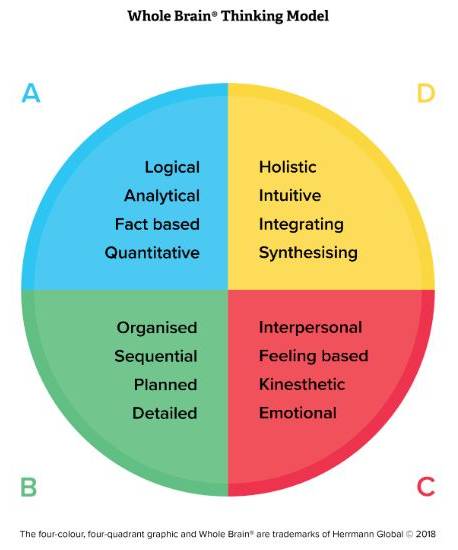Have you ever wondered why some of your most talented team members clash? Or why certain projects flow smoothly while others seem to get stuck in endless debates? The answer might not lie in what your team is thinking, but in how they’re thinking.
The Hidden Dynamic in Every Team
Picture this scenario: Your marketing manager presents a brilliant new campaign strategy. It’s creative, future-focused, and could transform your brand presence. But instead of enthusiasm, your operations director responds with a barrage of questions about implementation timelines and resource allocation. Meanwhile, your finance manager is asking for ROI projections, and your people and culture lead is concerned about how the team will manage the increased workload.
Sound familiar?

What’s fascinating is that this isn’t actually a conflict. It’s different thinking preferences in action, and understanding this could be the key to unlocking your team’s full potential.
Understanding Thinking Preferences with HBDI®
Think of thinking preferences in the same way you think of being right handed or left handed. In the same way most people favour using their right or left hand as a preference to pick things up or write, our brains have preferred ways of processing information and approaching challenges.
The HBDI® (Herrmann Brain Dominance Instrument) helps us understand these preferences through four distinct thinking styles:
Analytical Thinking (Blue)
- Focuses on facts, logic, and quantitative analysis
- Prioritises data-driven decisions
- Values clear metrics and proven results
Practical Thinking (Green)
- Emphasises implementation and organisation
- Focuses on detailed planning and execution
- Values structure and reliability
Relational Thinking (Red)
- Centres on people and emotions
- Prioritises team harmony and communication
- Values connection and collaboration
Experimental Thinking (Yellow)
- Generates innovative ideas and possibilities
- Focuses on the future and strategic vision
- Values creativity and exploration
Why This Matters for Your Business
Understanding thinking preferences isn’t just interesting—it’s transformative for your business. Here’s why:
- Enhanced Problem-Solving When you understand thinking preferences, what looks like conflict often reveals itself as complementary perspectives. Your analytical thinker ensures decisions are sound, your practical thinker makes them achievable, your relational thinker keeps everyone engaged, and your experimental thinker pushes boundaries for better solutions.
- Improved Communication Knowing how different team members prefer to receive and process information allows you to communicate more effectively. For instance, when presenting a new initiative:
- Analytical thinkers need to see the data
- Practical thinkers want clear action steps
- Relational thinkers need to understand the people impact
- Experimental thinkers want to see the big picture vision
- Better Team Composition Understanding thinking preferences helps you build more balanced teams. Rather than seeing differences as obstacles, you can leverage them as strengths.
The Leadership Challenge
As a leader, your own thinking preferences influence how you:
- Make decisions
- Communicate with your team
- Prioritise initiatives
- Solve problems
The question isn’t whether these preferences affect your leadership—it’s whether you’re aware of how they do.
Moving from Awareness to Action
Understanding thinking preferences is your first step toward better team dynamics. Here’s what becomes possible:
- Reduced Conflict: When team members understand and appreciate different thinking styles, perceived conflicts often dissolve into productive discussions.
- Faster Decision-Making: Teams that leverage different thinking styles make more well-rounded decisions more quickly.
- Increased Innovation: Diverse thinking styles bring different perspectives, leading to more innovative solutions.
- Improved Engagement: When people feel their thinking style is valued, they engage more fully with their work.
The Path Forward
Creating a high-performing team isn’t about finding people who think alike—it’s about understanding and leveraging different thinking preferences. The HBDI® assessment provides a framework for understanding these differences and turning them into advantages.
Ready to Transform Your Team Dynamics?
If you’re curious about how understanding thinking preferences could benefit your team, let’s talk. I offer both standalone HBDI® assessments and comprehensive coaching packages that help you apply these insights to your specific business challenges.
Book a Dream Team Discovery Call to explore how understanding thinking preferences could transform your team dynamics. During this call, we’ll:
- Discuss your current team challenges
- Explore how thinking preferences might be influencing your team dynamics
- Identify specific opportunities for improving team performance
- Determine if HBDI® assessment would benefit your team
Understanding thinking preferences isn’t just another business tool—it’s a fundamental shift in how we view team dynamics. Ready to see your team in a new light?
About Paula

If you're growing a team in-house or online, Paula Maidens can help!


